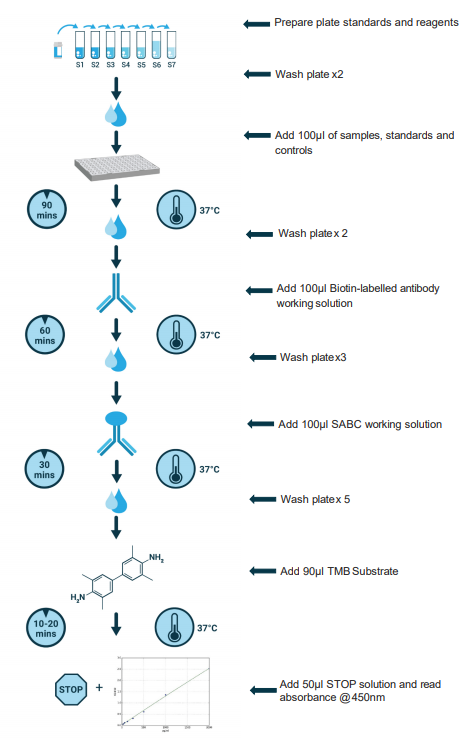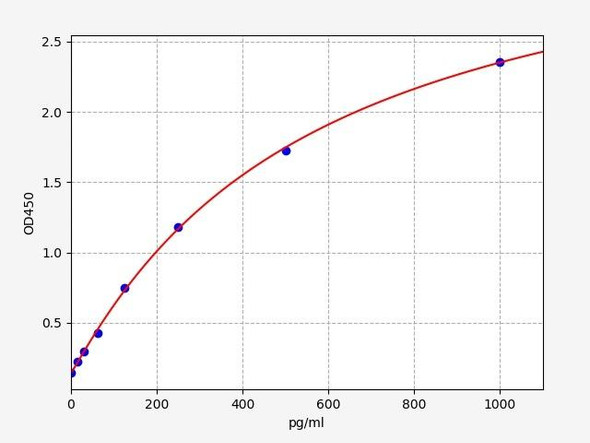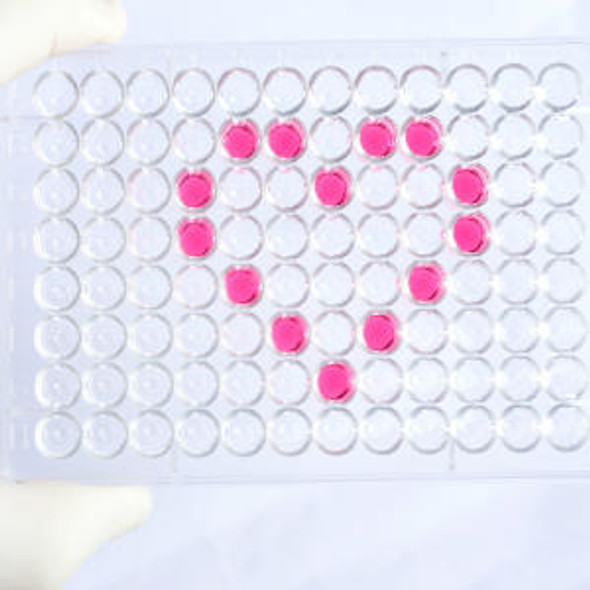Hamster IL-1 (Interleukin-1) ELISA Kit
- SKU:
- HMFI0012
- Product Type:
- ELISA Kit
- Size:
- 96 Assays
- Uniprot:
- A0A1U7Q4M0
- Sensitivity:
- 9.375pg/ml
- Range:
- 15.625-1000pg/ml
- ELISA Type:
- Sandwich ELISA, Double Antibody
- Synonyms:
- IL-1 ELISA Kit, Interleukin-1 ELISA Kit
- Reactivity:
- Hamster
Description
How our Hamster IL-1 (Interleukin-1) ELISA Kit works?
The Assay Genie ELISA (enzyme-linked immunosorbent assays) assay kits are designed for the quantitative measurement of analytes in a wide variety of samples. As today's scientists demand high quality consistent data for high impact journals, Assay Genie have developed a range of sensitive, fast and reliable ELISA kit assays to meet and exceed those demands. Our assay kits use a quantitative sandwich ELISA technique and each kit comes with highly specific antibodies pre-coated onto a 96-well microtiter plate.At Assay Genie we understand the need for speed! Therefore, we have developed an ultra-fast protocol meaning you achieve your results rapidly. So, once you have prepared and plated your samples, blanks and standards, you simply incubate with a highly specific biotin-conjugated primary antibody and Avidin conjugated to Horseradish Peroxidase (HRP) and incubate for the appropriate length of time. After washing the plate according to the protocol and addition of the TMB (3,3',5,5'-Tetramethylbenzidine) solution, the appearance of a blue colour should be detected due to an enzymatic reaction catalysed by HRP. Next step is the addition of the Stop Solution which terminates the HRP reaction and the blue colour turns yellow with the signal intensity measured on a plate reader at 450nm. The amount of bound Pentraxin 3 / TSG-14 is proportional to the signal generated by the reaction meaning the kit assay gives you a quantitative measurement of the analyte in your samples.Hamster IL-1 (Interleukin-1) ELISA Kit - Data
| Product SKU | HMFI0012 | ||||||||||||||||
| Alias | IL-1 ELISA Kit, Interleukin-1 ELISA Kit | ||||||||||||||||
| Detection method | Sandwich ELISA. | ||||||||||||||||
| Application | See table above. | ||||||||||||||||
| Size | 96T | ||||||||||||||||
| Range | 15.625-1000pg/ml | ||||||||||||||||
| Sensitivity | <9.375pg/ml | ||||||||||||||||
| Storage | 2-8'C for 6 months | ||||||||||||||||
| Recovery | Matrices listed below were spiked with certain level of IL-1 and the recovery rates were calculated by comparing the measured value to the expected amount of IL-1 in samples.
| ||||||||||||||||
| Linearity | The linearity of the kit was assayed by testing samples spiked with appropriate concentration of IL-1 and their serial dilutions. The results were demonstrated by the percentage of calculated concentration to the expected.
| ||||||||||||||||
| CV(%) | Intra-Assay: CV<8% | ||||||||||||||||
| Note | For Research Use Only |
Hamster IL-1 (Interleukin-1) ELISA Kit Protocol
The below protocol is a sample protocol for Hamster IL-1(Interleukin-1) ELISA Kit using a biotinylated detection antibody and streptavidin-HRP. Sandwich ELISAs allow for the detection and quantification of an analyte in a sample by using known analyte concentrations as standards and plotting absorbance of known concentrations vs known standard concentrations. This allows the researcher to calculate the amount of IL-1 present in their sample.When diluting samples and reagents, they must be mixed completely and evenly. Before adding TMB into wells, equilibrate TMB Substrate for 30 minutes at 37°C. It is recommended to plot a standard curve for each test.
Sandwich Protocol
Kit Protocol:
| 1. | Set standard, test samples (diluted at least 1/2 with Sample Dilution Buffer), control (blank) wells on the pre-coated plate respectively, and then, records their positions. It is recommended to measure each standard and sample in duplicate. Wash plate 2 times before adding standard, sample and control (blank) wells! |
| 2. | Prepare Standards: Aliquot 100ul of zero tube, 1st tube, 2nd tube, 3rd tube, 4th tube, 5th tube, 6th tube and Sample Dilution Buffer (blank) into the standard wells |
| 3. | Add Samples: Add 100ul of properly diluted sample into test sample wells. |
| 4. | Incubate: Seal the plate with a cover and incubate at 37°C for 90 minutes. |
| 5. | Wash: Remove the cover and discard the plate content, and wash plate 2 times with Wash Buffer. Do NOT let the wells dry completely at any time. |
| 6. | Biotin-labeled Antibody: Add 100ul Biotin-labeled antibody working solution into above wells (standard, test sample and blank wells). Add the solution at the bottom of each well without touching the sidewall, cover the plate and incubate at 37°C for 60 minutes. |
| 7. | Wash: Remove the cover, and wash plate 3 times with Wash Buffer, and let the Wash Buffer stay in the wells for 1-2 minutes each time |
| 8. | HRP-Streptavidin Conjugate (SABC): Add 100ul of SABC Working Solution into each well, cover the plate and incubate at 37°C for 30 minutes |
| 9. | Wash: Remove the cover and wash plate 5 times with Wash Buffer, and let the wash buffer stay in the wells for 1-2 minutes each time. |
| 10. | TMB Substrate: Add 90ul TMB Substrate into each well, cover the plate and incubate at 37°C in dark within 10-20 minutes. (Note: The reaction time can be shortened or extended according to the actual color change, but not more than 30 minutes. You can terminate the reaction when apparent gradient appeared in standard wells.) |
| 11. | Stop: Add 50ul Stop Solution into each well. The color will turn yellow immediately. The adding order of Stop Solution should be as the same as the TMB Substrate Solution. |
| 12. | OD Measurement: Read the O.D. absorbance at 450nm in Microplate Reader immediately after adding the stop solution. |
Hamster IL-1 ELISA Kit components | 96 Assays | Storage |
| ELISA Microplate (Dismountable) | 8×12 strips | 4°C for 6 months |
| Lyophilized Standard | 2 | 4°C/-20°C |
| Sample/Standard Dilution Buffer | 20ml | 4°C |
| Biotin-labeled Antibody(Concentrated) | 120ul | 4°C (Protect from light) |
| Antibody Dilution Buffer | 10ml | 4°C |
| HRP-Streptavidin Conjugate(SABC) | 120ul | 4°C (Protect from light) |
| SABC Dilution Buffer | 10ml | 4°C |
| TMB Substrate | 10ml | 4°C (Protect from light) |
| Stop Solution | 10ml | 4°C |
| Wash Buffer(25X) | 30ml | 4°C |
| Plate Sealer | 5 | - |
Other materials and equipment required:
The Assay Genie Hamster IL-1 ELISA Kit will require other equipment and materials to carry out the assay. Please see list below for further details.
- Microplate reader with 450 nm wavelength filter
- Multichannel Pipette, Pipette, microcentrifuge tubes and disposable pipette tips
- Incubator
- Deionized or distilled water
- Absorbent paper
- Buffer resevoir
Sample Preparation
ELISAアッセイを実施する場合、可能な限り最良の結果を達成するためにサンプルを準備することが重要です。以下に、さまざまなサンプルタイプのサンプルを準備するための手順のリストを示します。
| Sample Type | Protocol |
Serum | If using serum separator tubes, allow samples to clot for 30 minutes at room temperature. Centrifuge for 10 minutes at 1,000x g. Collect the serum fraction and assay promptly or aliquot and store the samples at -80°C. Avoid multiple freeze-thaw cycles. If serum separator tubes are not being used, allow samples to clot overnight at 2-8°C. Centrifuge for 10 minutes at 1,000x g. Remove serum and assay promptly or aliquot and store the samples at -80°C. Avoid multiple freeze-thaw cycles. |
Plasma | Collect plasma using EDTA or heparin as an anticoagulant. Centrifuge samples at 4°C for 15 mins at 1000 × g within 30 mins of collection. Collect the plasma fraction and assay promptly or aliquot and store the samples at -80°C. Avoid multiple freeze-thaw cycles. Note: Over haemolysed samples are not suitable for use with this kit. |
Urine & Cerebrospinal Fluid | Collect the urine (mid-stream) in a sterile container, centrifuge for 20 mins at 2000-3000 rpm. Remove supernatant and assay immediately. If any precipitation is detected, repeat the centrifugation step. A similar protocol can be used for cerebrospinal fluid. |
Cell culture supernatant | Collect the cell culture media by pipette, followed by centrifugation at 4°C for 20 mins at 1500 rpm. Collect the clear supernatant and assay immediately. |
Cell lysates | Solubilize cells in lysis buffer and allow to sit on ice for 30 minutes. Centrifuge tubes at 14,000 x g for 5 minutes to remove insoluble material. Aliquot the supernatant into a new tube and discard the remaining whole cell extract. Quantify total protein concentration using a total protein assay. Assay immediately or aliquot and store at ≤ -20 °C. |
Tissue homogenates | The preparation of tissue homogenates will vary depending upon tissue type. Rinse tissue with 1X PBS to remove excess blood & homogenize in 20ml of 1X PBS (including protease inhibitors) and store overnight at ≤ -20°C. Two freeze-thaw cycles are required to break the cell membranes. To further disrupt the cell membranes you can sonicate the samples. Centrifuge homogenates for 5 mins at 5000xg. Remove the supernatant and assay immediately or aliquot and store at -20°C or -80°C. |
Tissue lysates | Rinse tissue with PBS, cut into 1-2 mm pieces, and homogenize with a tissue homogenizer in PBS. Add an equal volume of RIPA buffer containing protease inhibitors and lyse tissues at room temperature for 30 minutes with gentle agitation. Centrifuge to remove debris. Quantify total protein concentration using a total protein assay. Assay immediately or aliquot and store at ≤ -20 °C. |
Breast Milk | Collect milk samples and centrifuge at 10,000 x g for 60 min at 4°C. Aliquot the supernatant and assay. For long term use, store samples at -80°C. Minimize freeze/thaw cycles. |








